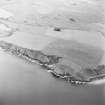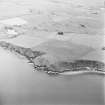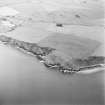Cruggleton, Old Parish Church And Burial Ground
Burial Ground (Medieval), Church (12th Century)
Site Name Cruggleton, Old Parish Church And Burial Ground
Classification Burial Ground (Medieval), Church (12th Century)
Alternative Name(s) Cruggleton Church And Walled Burial Ground
Canmore ID 63259
Site Number NX44SE 9
NGR NX 47796 42810
Datum OSGB36 - NGR
Permalink http://canmore.org.uk/site/63259
- Council Dumfries And Galloway
- Parish Sorbie
- Former Region Dumfries And Galloway
- Former District Wigtown
- Former County Wigtownshire
NX44SE 9 47796 42810
Cruggleton Church
(restored) [NAT]
OS (GIS) MasterMap, July 2009.
NX 47796 42810 Cruggleton Church, still surrounded by a burial ground, was erected in the second quarter of the 12th. century. It had long been ruinous, when c.1890 it was restored by the Marquess of Bute. Sufficient details and fragments remained for an accurate restoration. The building consists of a nave 35' x 20'6", and a chancel, 21' x 15'9", separated by a round-headed Norman Arch, which is almost all original, as is a considerable height of the N wall.
The church was granted to Whithorn Priory in 1424, and it was served by a vicar, but the parish has been united with Sorbie since the 17th. century.
RCAHMS 1912, visited 1911; C A R Radford 1951.
As described and planned.
Visited by OS (DWR) 23 January 1973.
Publication Account (1986)
Reflecting the patronage of the lords of nearby Cruggleton Castle (NX 484429) and the architectural influence of Whithorn (no. 79), this is the most complete small Romanesque church in the region. In its existing form, however, the building is largely the product of a scheme of restoration carried out in about 1890 on what was then a ruin, a line of tiles marking the base of the rebuilt work. Outside, the character of the original masonry and doorway can best be seen on the north side; of the windows only the small east and west single-light openings are old. Inside, there is an original chancel arch which has been partly reset; it has a pair of shafted orders with cubical and scalloped capitals and Irish-style bulbous bases. The church is laid out on a simple two-chambered plan, with nave and narrower chancel.
Which of the 12th century lords of Galloway was responsible for this work is not known, although the strongest claims have been made in favour of Fergus (d. 1161). In 1427 its modest revenues were appropriated by the Bishop of Whithorn, and in the 17th century the small parish was united with that of Sorbie. The apparent physical isolation of the church may be deceptive, although no traces of a village settlement have been found in its vicinity.
Information from ‘Exploring Scotland’s Heritage: Dumfries and Galloway’, (1986).








































































































































